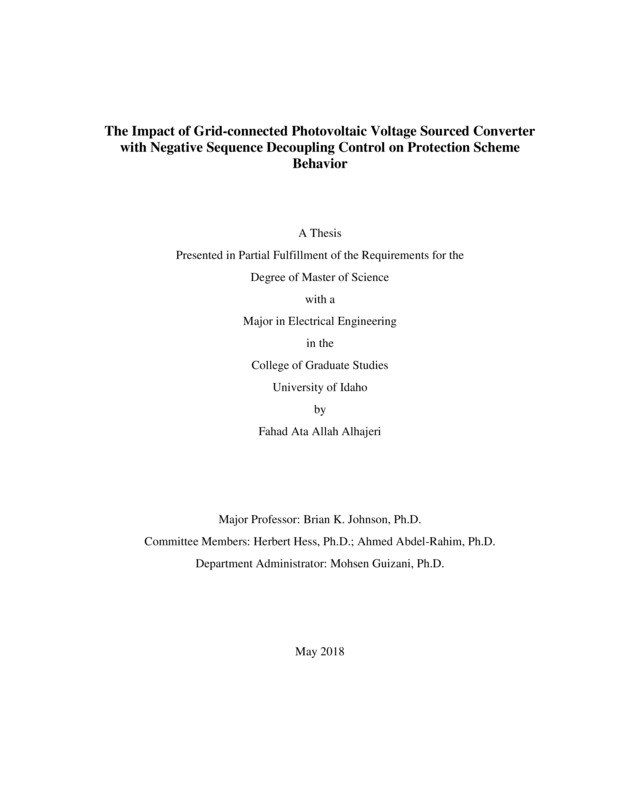The Impact of Grid-connected Photovoltaic Voltage Sourced Converter with Negative Sequence Decoupling Control on Protection Scheme Behavior
Alhajeri, Fahad A. (2018-05). The Impact of Grid-connected Photovoltaic Voltage Sourced Converter with Negative Sequence Decoupling Control on Protection Scheme Behavior. Theses and Dissertations Collection, University of Idaho Library Digital Collections. https://www.lib.uidaho.edu/digital/etd/items/alhajeri_idaho_0089n_11320.html
- Title:
- The Impact of Grid-connected Photovoltaic Voltage Sourced Converter with Negative Sequence Decoupling Control on Protection Scheme Behavior
- Author:
- Alhajeri, Fahad A
- Date:
- 2018-05
- Keywords:
- decoupled double synchronous reference frames control distance and overcurrent element EMTP-ATPDraw program ATP Grid-connected PV System Protection scheme relay VSC Distribution line Faults
- Program:
- Electrical and Computer Engineering
- Subject Category:
- Electrical engineering
- Abstract:
-
This thesis focuses on grid-connected PV systems and their impact on protection scheme performance during system fault conditions. The main objective of this work is to design a simulation model that can simulate the response of the system during different fault applications. The ATP program is used to model the grid-connected PV system along with the VSC control schemes based on the decoupled double synchronous reference frame method. The ATP model can be used as a teaching tool in courses and for research purposes. Different types of faults are applied to the power distribution system, with a distance protection element (21) proposed to protect the distribution system. An inverse-time overcurrent element (51) is used to protect the collector system on the ac-side of the VSC. Due to the characteristics of the VSC, it is controlled to limit the fault current contribution to less than 1.2 pu of the maximum current value. This causes the protection elements to either not trip or not trip correctly. In addition, due to the limited fault current and the weak source of the grid-connected PV system compared to the grid system source, the mho distance element mislocates the fault location. It calculates that the apparent fault location is much closer to the PCC than it actually is. This study indicates that the performance of the supervised distance element and the inverse-time overcurrent element are impacted by the grid-connected PV system. Therefore, in the fault analysis study and the protection schemes settings, this type of system should not be modeled as a conventional power generator.
- Description:
- masters, M.Engr., Electrical and Computer Engineering -- University of Idaho - College of Graduate Studies, 2018-05
- Major Professor:
- Johnson, Brian k
- Committee:
- Hess, Herbert h; Abdel-rahim, Ahmed
- Defense Date:
- 2018-05
- Identifier:
- Alhajeri_idaho_0089N_11320
- Type:
- Text
- Format Original:
- Format:
- application/pdf
- Rights:
- In Copyright - Educational Use Permitted. For more information, please contact University of Idaho Library Special Collections and Archives Department at libspec@uidaho.edu.
- Standardized Rights:
- http://rightsstatements.org/vocab/InC-EDU/1.0/

